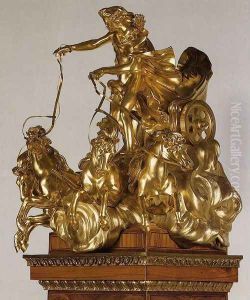Philippe Caffieri Paintings
Philippe Caffieri was a prominent French sculptor and designer, particularly known for his exquisite work in the Rococo style during the 18th century. Born on July 18, 1714, in Paris, France, he was part of the illustrious Caffieri family, which included several generations of renowned artists and craftsmen. His father, Jacques Caffieri, was a famous bronze worker and sculptor, and it was under his guidance that Philippe developed his skills and passion for art.
Philippe Caffieri was well-known for his work as a bronzier and chaser, especially in the creation of decorative arts such as candlesticks, clocks, and mounts for furniture. He inherited his father's workshop in 1755, and his works were highly sought after by the French nobility and the royal court. Caffieri's creations were characterized by their intricate designs, fluid lines, and ornamental motifs, which were typical of the Rococo style. His ability to blend form and function in his designs made him a favorite among the patrons of his time.
During his career, Caffieri received numerous commissions from the French royal family and was involved in the decoration of several royal palaces, including Versailles. His work often involved collaborating with other artists and cabinetmakers, such as Jean-François Oeben and Jean-Henri Riesener, to produce pieces that were both beautiful and functional. Philippe Caffieri's legacy continued through his family, with his son Jean-Jacques Caffieri also becoming a notable sculptor.
Philippe Caffieri's contribution to the decorative arts of the Rococo period left an indelible mark on French design. He passed away on June 8, 1774, in Paris. His works continue to be admired for their elegance and artistry and are preserved in various museums and collections around the world, including the Louvre in Paris and the Metropolitan Museum of Art in New York.
